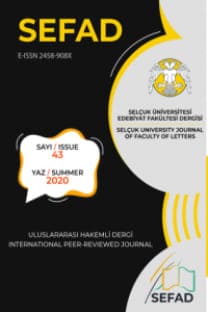RUS DİLİNDEKİ İFADE ZENGİNLİĞİNİN ÇEVİRİ BİLİMİNE VE RUSÇA ÖĞRENİMİNE KATKISI
Bir dilde cümlenin esas anlamının korunarak çeşitli gramer kalıplarıyla aktarılabilmesi, o dildeki zengin ifade biçimlerine işaret etmektedir. Rus dili aktarılmak istenen söylemin farklı yollarla ifade edilebilmesi olanağına sahip özelliğiyle ifade çeşitliliği açısından zenginlik arz eden dillerdendir. Rusçanın bu özelliği kullanımda belirli koşullarda birbirlerinin yerine geçebilen, anlam açısından birbirine yakın olan ancak her biri kendine has özelliklere sahip sıfat-fiil, zarf-fiil, isim-fiil gibi farklı gramer kalıplarıyla oluşturulabilen paralel cümle kavramına işaret etmektedir. Rusçadaki paralel cümleler çeşitli dil öğeleriyle oluşturulabilmelerinin yanı sıra konuşma dili ve yazı dili olarak kullanım alanı açısından da birbirinden ayrılabilmekte, bu ise cümlenin kullanımdaki tercih koşullarına etki etmektedir. Bir ifadenin farklı yollarla aktarılabilme özelliği, özellikle çeviri sırasında çevirmene ya da konuşana mevcut çeşitli alternatifler sayesinde belirtilmek isteneni dile getirmede kolaylık sağlayabilmektedir. Bu çalışmada yapı ve işlev olarak farklılık gösteren ancak anlam açısından benzerlik arz eden Rusçadaki paralel cümle kavramı, kullanım alanları ve kuralları içerisinde ele alınacaktır. Öte yandan bu cümlelerin çevirideki yansımaları, olası alternatif cümle örnekleriyle Sabahattin Alinin ilk kez 1990 yılında Rusçaya çevrilmiş olan Kürk Mantolu Madonna adlı eseri üzerinde incelenecektir.
CONTRIBUTION OF THE ABUNDANCE OF EXPRESSIONS IN RUSSIAN LANGUAGE TO TRANSLATING AND LEARNING RUSSIAN
Maintaining the original meaning of a sentence in one language, while being able to use various grammatical structures for conveying the same meaning indicate rich forms of expressions in that language. As one of its features, the Russian language enables the transfer of the discourse in different ways which shows that the language is rich in terms of diversity of expressions. This feature of Russian language points to the concept of parallel structures which are under certain conditions interchangeable in use and close to each other in terms of meaning, and also which can be formed by the different grammatical structures as participle, gerund, infinitive while each has its own characteristic features. While parallel structures can be created with various language elements, they can be separated from each other in terms of their use in spoken language and written language as well. This case affects the usage preferences of sentences. An expression s feature of transferability in different ways and with various alternatives provides ease for the translator or speaker especially during the translation. In this study, the parallel structures in Russian language that differ in structure and function, but which are semantically close will be discussed within the framework of their areas and rules of usage. Besides, in this paper the reflections of these sentences in the translation will be examined in the novel of Sabahattin Ali s Madonna in a Fur Coat , which was translated to Russian first-time in 1990, with examples of possible alternative sentences.
___
- AKAY, Recep (2005). Dilbilgisi ve Stilistik, Çanakkale Onsekiz Mart Üniversitesi Eğitim Fakültesi Yabancı Diller Bölümü Alman Dili Eğitimi Ana Bilim Dalı, Uluslararası IV. Dil, Yazın ve Değişbiliş Sempozyumu Bildirileri, Çanakkale. 17-19 Haziran 2005, s. 187-194, http://turkoloji.cu.edu.tr/DILBILIM/recep_akay_dilbilgisi_ve_stilistik.pdf, 15.11.2013.
- BREDEEV L.V., BUTENKO A.A.Leksiko-stilistiçeskie trabsformatsii pri perevode http://belpaese2000.narod.ru/Trad/trasform01.htm (06.03.2014).
- GVOZDEV A.N. (1965). Oçerki po stilistike russkogo yazıka. Morfologiya. Glagol, Moskova: İzdatelstvo Prosveşeniya. http://www.interword.se/Syntax/Lektionsmaterial/GVOZDEV/m/stil525.htm, (20.12.2013)
- GOLUB İ.B. (2010). Stilistika russkogo yazıka. Uçeb. posobie. 4-e izd. Moskva: Ayris-press.
- KARAHAN, Leyla (2007). Sonra, Önce Kelimelerinin Edat Kategorisi İçerisindeki Durumu, Uluslararası Türklük Araştırmaları Sempozyumu, 25- 27 Nisan 2007, Erzurum. Dil Araştırmaları, Ankara, S.1: 3940. http://turkoloji.cu.edu.tr/YENI%20TURK%20DILI/leyla_karahan_sonra_onc e_edat_kategorisi.pdf (24.04.2014).
- KAZARİNA S.G., MİLYUK A.V., USAÇEVA M.P. (2004). Stilistika i kultura reçi: Uçeb. pos. po russkomu yazıkyu. İzd. Rostov-n/Donu: Feniks.
- KOJİNA M.N., DUSKAEVA L.R., SALİMOVSKİY V.A. (2014). Stilistika russkogo yazıka, Moskva: Flinta, Nauka.
- MİTYAKİNE, E. YEREMİNA (2010). Nekotorıe osobennosti stilistiçeskih priemov perevoda. Germes: nauç.-hudoj. sb.: vıp. II. / redkol. A.N. Zlobin, L.M. Lemaykina, A.V. Puzakov (i dr.); sost. A.N. Zlobin. Saransk: Afanasyev V.S. (2010): 53-56.
- ROZENTAL D.E. (2011). Spravoçnik po russkomu yazıku. Praktiçeskaya stilistika. M.: Oniks, Mir i Obr., Astrel.
- ROZENTAL D.E. (2014). Spravoçnik po pravopisaniyu i literaturnoy pravke. Pod. Red. İ.B. Golub. Moskva: Ayris Press.
- SABAHATTİN Ali (1997). Kürk Mantolu Madonna, Yapı Kredi Yay. İstanbul.
- SABAHATTİN Ali (1990). İzbrannoe: Per. s turetsk. Madonna v mehovom palto. Perevod s turetskogo L. Medvedko. M.: Hud. Lit.
- Yayın Aralığı: Yılda 2 Sayı
- Başlangıç: 1981
- Yayıncı: Selçuk Üniversitesi Edebiyat Fakültesi
Sayıdaki Diğer Makaleler
JUAN GOYTISOLO'NUN KIRK GÜNLÜK SÜRE ADLI ROMANINDA DİNSEL BAĞLAMDA KÜLTÜRLER ARASI DİYALOG
MARCUS LICINIUS CRASSUS (M.Ö. 112-53)'UN SURİYE VALİLİĞİ VE BÖLGESEL GÜÇLER
TÜRKÇE KELİMELERİN EFSANE DÜNYASINDA ANLAMLANDIRILMASI VE ÇÖZÜMLENMESİ
LİVÂYÎ'NİN MANZÛM YASİN TEFSİRİ
DEKABRİST ŞİİRİNİN ÖZELLİKLERİ
HASAN RIZÂYÎ'NİN CÛY-I RAHMET ADLI MANZUM GÜLİSTÂN TERCÜMESİ
POZİTİVİZM Tarihsel Süreç İçerisindeki Gelişimi ve Sosyolojik Düşünceye Etkileri
RUS DİLİNDEKİ İFADE ZENGİNLİĞİNİN ÇEVİRİ BİLİMİNE VE RUSÇA ÖĞRENİMİNE KATKISI
